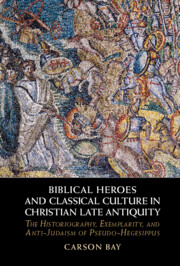 Biblical Heroes and Classical Culture in Christian Late Antiquity
Biblical Heroes and Classical Culture in Christian Late Antiquity Book contents
- Biblical Heroes and Classical Culture in Christian Late Antiquity
- Biblical Heroes and Classical Culture in Christian Late Antiquity
- Copyright page
- Dedication
- Contents
- Acknowledgments
- Abbreviations
- Introduction
- 1 On the Destruction of Jerusalem
- 2 Hebrew versus Jew
- 3 Abraham, Ethnography, Exemplarity, and Oratory at De Excidio 5.41.2 and 5.53.1
- 4 Exemplarity and National Decline at De Excidio 5.2.1
- 5 Jewish and Christian Martyrdom at De Excidio 3.2 and 5.22
- 6 King David as Christian-Classical Exemplum in Pseudo-Hegesippus
- 7 Elisha, Disaster, and Extended Exemplarity in De Excidio
- 8 A Classical World of Biblical Exempla
- 9 A Christian World of Hebrew Exempla
- Conclusion
- Appendix 1: Old Testament Exempla in De Excidio, A–Z
- Appendix 2: Pseudo-Hegesippus’ Sources
- Bibliography
- Source Index
- General Index
Introduction
Published online by Cambridge University Press: 10 November 2022
- Biblical Heroes and Classical Culture in Christian Late Antiquity
- Biblical Heroes and Classical Culture in Christian Late Antiquity
- Copyright page
- Dedication
- Contents
- Acknowledgments
- Abbreviations
- Introduction
- 1 On the Destruction of Jerusalem
- 2 Hebrew versus Jew
- 3 Abraham, Ethnography, Exemplarity, and Oratory at De Excidio 5.41.2 and 5.53.1
- 4 Exemplarity and National Decline at De Excidio 5.2.1
- 5 Jewish and Christian Martyrdom at De Excidio 3.2 and 5.22
- 6 King David as Christian-Classical Exemplum in Pseudo-Hegesippus
- 7 Elisha, Disaster, and Extended Exemplarity in De Excidio
- 8 A Classical World of Biblical Exempla
- 9 A Christian World of Hebrew Exempla
- Conclusion
- Appendix 1: Old Testament Exempla in De Excidio, A–Z
- Appendix 2: Pseudo-Hegesippus’ Sources
- Bibliography
- Source Index
- General Index
Summary
The Introduction frames the study as an argument about the use of biblical figures within the narrative of On the Destruction of Jerusalem (De Excidio Hierosolymitano). Bay maintains that a survey of the scriptural characters that appear in this text suggest that these remembered heroes were an important tool for how Pseudo-Hegesippus conceived of and communicated late Second Temple period Jewish history from a late antique Christian perspective. This chapter also recommends the Old Testament exempla of On the Destruction of Jerusalem as a good place to start literarily for approaching and understanding the background, aims, and inner logic of this text. Bay further explains how the biblical exempla of Pseudo-Hegesippus often appear within speeches placed into the mouths of historical characters in the narrative, a typical literary feature of ancient historiography. Finally, the Introduction helps situate this study within the history of scholarship – not only within the little work done on Pseudo-Hegesippus, but also in the context of various scholarly discussions in Classics, biblical studies, early Christianity, Jewish-Christian relations, and late antique literature.
- Type
- Chapter
- Information
- Biblical Heroes and Classical Culture in Christian Late AntiquityThe Historiography, Exemplarity, and Anti-Judaism of Pseudo-Hegesippus, pp. 1 - 16Publisher: Cambridge University PressPrint publication year: 2022
